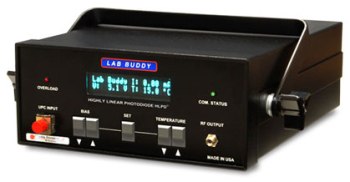Discovery Semiconductors is employing its Highly Linear Photodiode (HLPD) technology for the production of low-phase noise optoelectronic clocks that realize advancements such as ultra-quick analog-to-digital converters.
Discovery Semiconductors’ photodiode technology allows below 5 rad/W of phase linearity, a record low value, according to the company. By utilizing its HLPD Lab Buddy equipment, the company demonstrated the reduction of nonlinear distortions by maximizing the bias of the photodiode.
 HLPD Lab Buddy
HLPD Lab Buddy
At l’Observatoire de Paris, Discovery Semiconductors demonstrated the linearity value required for the reduction of timing fluctuation and phase noise in optoelectronic solutions.
The researchers at LNE-SYRTE of the l’Observatoire de Paris were keen to take the advantage of using the HLPD technology in producing ultra-low phase noise microwave sources for remote harmonization of huge facilities, longer baseline interferometry and radar.
According to Dr. Shubo Datta, who serves as Discovery Semiconductors’ photonics engineer, the reduction in timing fluctuation eliminates synchronization problems that restrict dynamic and bandwidth range of analog-to-digital converters, resulting in ultra-fast analog-to-digital converters.
Datta further said that the HLPD Lab Buddy controls the photodiode’s temperature for its reliability in the complete range of its bias. The Lab Buddy’s temperature control and programmable bias characteristics allow it to be integrated with numerous lab applications such as nonlinear distortion testing.